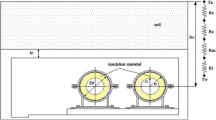Abstract
In this study, performance analysis of brazed compact heat exchanger is investigated experimentally. Chevron angle of brazed compact heat exchanger is 30°. Effectiveness analysis of brazed compact heat exchanger at different working conditions is examined. The highest effectiveness value is 49%. While mass flow rate is 0.21 kg/s, the peak value for heat transfer rate is obtained as 18 kW. This study shows that an increase in the Reynolds number results in an increase in Nusselt number. While Reynolds number is 2125.72, the peak value for Nusselt number is 40. Also, the raise in the Reynolds number causes the Nusselt number to increase, which raises the heat transfer coefficient, and the heat transfer coefficient also reduces heat transfer rate. In addition, exergy analysis of the brazed compact heat exchanger is made. The peak exergy loss value is 12.3 kW and the least exergy loss value is 5.03 kW for brazed compact heat exchanger.








Similar content being viewed by others
Abbreviations
- A :
-
Heat transfer area of the plate (m2)
- A c :
-
Cross-sectional area (m2)
- c p :
-
Specific heat capacity (kJ/kg°K)
- C c :
-
Heat capacity (W/°K)
- D h :
-
Channel hydraulic diameter (m)
- F :
-
Friction factor
- H :
-
Heat transfer coefficient (W/m2°K)
- K :
-
Thermal conductivity (W/m°K)
- L :
-
Length of the channel (m)
- \(\dot{m}\) :
-
Mass flow rate (kg s−1)
- Nu:
-
Nusselt number
- \({\dot{\text{Q}}}\) :
-
Heat transfer rate (W)
- P :
-
Pressure (Pa)
- P w :
-
Wet perimeter (m)
- T :
-
Temperature (°K)
- U :
-
Total heat transfer coefficient (W/m2°K)
- V :
-
Average velocity of fluid (m s−1)
- \(\Delta P\) :
-
Pressure loss between inlet and outlet of a channel (Pa)
- \(\Delta T_{{{\text{LMTD}}}}\) :
-
Logarithmic mean temperature difference (°K)
- ρ :
-
Fluid density (kg/m3)
- μ :
-
Dynamic viscosity (Pa s)
- β :
-
Chevron angle
- ε :
-
Effectiveness
- c :
-
Cold fluid
- h :
-
Hot fluid
- i :
-
Inlet
- max:
-
Maximum
- min:
-
Minimum
- o :
-
Outlet
- w :
-
Wet
References
Al-zahrani S, Islam MS, Xu F, Saha SC (2020) Thermal performance investigation in a novel corrugated plate heat exchanger. Int J Heat Mass Transf 148:119095. https://doi.org/10.1016/j.ijheatmasstransfer.2019.119095
Clare A, Chalker T, Davles PR (2008) Selective laser sintering of barium titanate-polymer composite films. J Mater Sci 43:3197–3202. https://doi.org/10.1007/s10853-007-2396-x
Durmuş A, Hüseyin B, İrfan K, Hasan G (2009) Investigation of heat transfer and pressure drop in plate heat exchangers having different surface profiles. Int J Heat Mass Transf 52:1451–1457. https://doi.org/10.1016/j.ijheatmasstransfer.2008.07.052
Genceli OF (2005) Measuring technique. Birsen Publishing House, İstanbul, Turkey
Genceli OF (2009) Heat exchangers, 4th edn. Birsen Publishing House, İstanbul, Turkey
Glazar V, Frankovic B, Trp A (2015) Experimental and numerical study of the compact heat exchanger with different microchannel shapes. Int J Refrig 51:144–153. https://doi.org/10.1016/j.ijrefrig.2014.06.017
Gullapalli VS, Sundén B (2014) CFD Simulation of heat transfer and pressure drop in compact brazed plate heat exchangers. Heat Transfer Eng 35(4):358–366. https://doi.org/10.1080/01457632.2013.828557
Gürel B, Akkaya VR, Göltaş M, Şen ÇN, Güler OV, Koşar Mİ, Keçebaş A (2020) Investigation on flow and heat transfer of compact brazed plate heat exchanger with lung pattern. Appl Therm Eng 175:115309. https://doi.org/10.1016/j.applthermaleng.2020.115309
Gut JAW, Pinto JM (2004) Optimal configuration design for plate heat exchangers. Int J Heat Mass Transf 47(22):4833–4848. https://doi.org/10.1016/j.ijheatmasstransfer.2004.06.002
Hesselgreaves JE, Law R, Reay DA (2017) Compact heat exchangers: selection, design and operation. Elsevier Ltd, Amsterdam
Incropera P, De Witt P (1990) Fundamentals of heat and mass transfer. Wiley, New York
Khan MR, Rai AK (2015) An experimental study of exergy in a corrugated plate heat exchanger. Int J Mech Eng Technol 11:16–22
Kılıç B (2013) Experimental investigation of effects to heat transfer of plate geometry with dynamic and thermal parameters in the plate heat exchangers. Ph.D. Thesis, Süleyman Demirel University, The Graduate School of Natural and Applied Sciences, Isparta (in Turkish). http://www.tekniktesisat.com.tr/
Kim HJ, Liebenberg L, Jacobi AM (2018) Convective boiling of R-134a near the micro-macroscale transition inside a vertical brazed plate heat exchanger. ASME J Heat Transf 140:091501. https://doi.org/10.1115/1.4039397
Longo GA, Mancin S, Righetti G, Zilio C (2019) Boiling of the new low-GWP refrigerants R1234ze(Z) and R1233zd(E) inside a small commercial brazed plate heat exchanger. Int J Refrig 104:376–385. https://doi.org/10.1016/j.ijrefrig.2019.05.034
Longo GA, Righetti G, Zilio C, Ortombina L, Zigliotto M, Brown JS (2020) Application of an artificial neural network (ANN) for predicting low-GWP refrigerant condensation heat transfer inside herringbone-type brazed plate heat exchangers (BPHE). Int J Heat Mass Transf 156:119824. https://doi.org/10.1016/j.ijheatmasstransfer.2020.119824
Moran MJ, Shapiro HN, Boettner DD, Bailey MB (2010) Fundamentals of engineering thermodynamics. Wiley, New york
Sarafraz M, Hormozi F (2016) Heat transfer, pressure drop and fouling studies of multi-walled carbon nanotube nano-fluids inside a plate heat exchanger. Exp Thermal Fluid Sci 72:1–11. https://doi.org/10.1016/j.expthermflusci.2015.11.004
Selbas R, Şencan A, Kılıç B (2009) Alternative approach in thermal analysis of plate heat exchanger. Heat Mass Transf 45:323–329. https://doi.org/10.1007/s00231-008-0427-z
Wang L, Sundén B, Manglik RM (2007) Plate heat exchangers: design. Applications and performance, Ashurst Lodge, Ashurst, Southampton, UK
Wu J, Ju Y (2019) Design and optimization of natural gas liquefaction process using brazed plate heat exchangers based on the modified single mixed refrigerant process. Energy 186:115819. https://doi.org/10.1016/j.energy.2019.07.149
Acknowledgement
The experiments were carried out in the experimental setup of Süleyman Demirel University Research Foundation (SDUBAP) financial support, under Project Number: 2810-D-11. Author wish to thank for the support.
Author information
Authors and Affiliations
Corresponding author
Additional information
Editorial responsibility: Q. Aguilar-Virgen.
Rights and permissions
About this article
Cite this article
Kılıç, B. Experimental analysis of energy and exergy in brazed compact heat exchanger. Int. J. Environ. Sci. Technol. 18, 3907–3914 (2021). https://doi.org/10.1007/s13762-020-03110-3
Received:
Revised:
Accepted:
Published:
Issue Date:
DOI: https://doi.org/10.1007/s13762-020-03110-3




